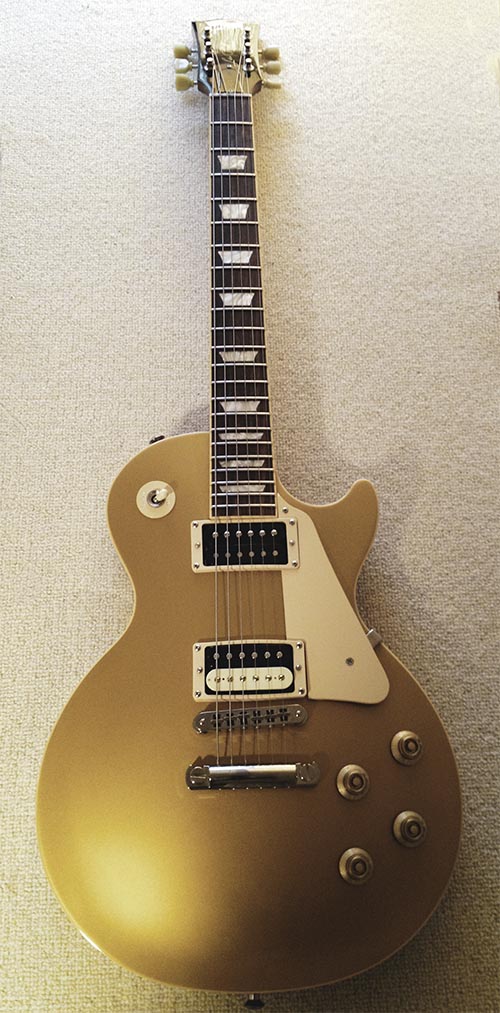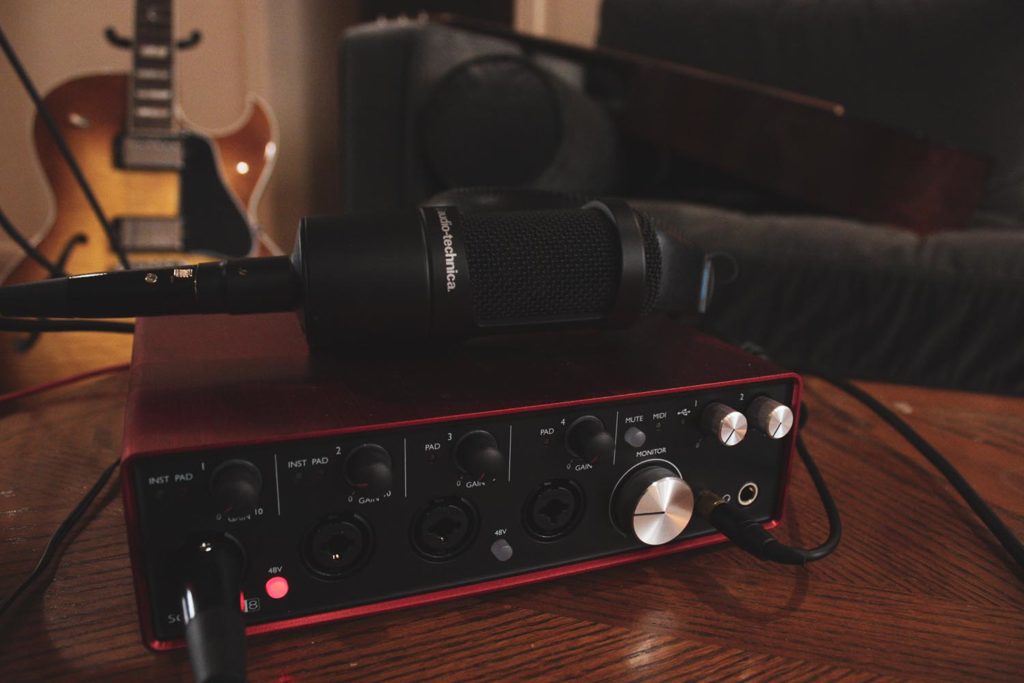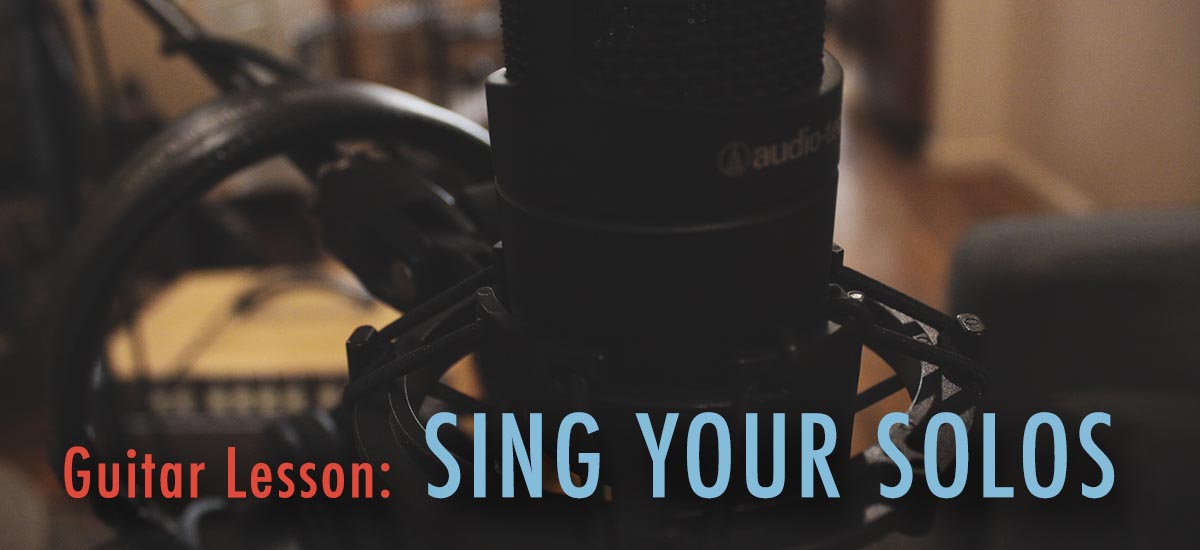The guitar is a unique instrument that creates opportunities and challenges when making music. We all know the opportunities. These are the fun things that I focus on most of the time: tremolos, strings, pickups, effects pedals, and the never ending pile of gear available to express ourselves in different ways.
One of the challenges that we face as guitar players is the instrument’s geometry. The way the frets align with the strings across 5ish octaves, tuned in (mostly) fourths, gives us an incredible array of possibilities. But it is within this grid that we encounter our roadblock: patterns.
The Problem of Pattern
What’s particularly difficult about this roadblock is that it doesn’t seem like a roadblock at first. To any new player, it’s a godsend.
From the beginning of time, the human brain has evolved to detect pattern. The seasons, the weather, movement of animals, and the shapes of plants. The world around us hints towards its secrets, the knowledge of its harmonies and dissonances, that is eluded to through visible pattern.

According to Big Think, “Quite simply, humans are amazing pattern-recognition machines. They have the ability to recognize many different types of patterns – and then transform these “recursive probabalistic fractals” into concrete, actionable steps.” [source]
We are evolutionarily disposed to identify the patterns of a fretboard, and this makes learning certain things quite easy. Once we spend some time with it, it’s easy for us to see patterns and shapes. How many of you can draw the pentatonic positions in your sleep, and why is the CAGED method so effective? These positions are easy to learn, teach, and utilize across keys. And all this without knowing the notes that are being played relative to the key (but more on that later).
Detecting patterns allowed us to detect danger and allowed us to survive a harsh world. Now that same mechanism strips us of creativity and holds us back from becoming the musicians we can be.
If you’re in the position as a guitar player where you feel like you’re in a rut, or you want to open up the possibilities of playing whatever is in your mind, then read on!
The Guitar is a Tool

As guitar players, we often forget this. The guitar is not where the music comes from. It is the tool which transfers the music that is created internally in our minds to the outside world. In our case, there can be many fun things that make up that middle ground. Guitars, pickups, effects pedals, and amps. These things help us shape our sound and can allow creativity. However, it is easy for us to forget. These things are all just tools, tools that act as a conduit between the music deep inside ourselves to the world outside.
And while patterns allow us to learn quickly and traverse across keys without knowing any real theory, the pure music in our minds is colored strongly by the muscle memory in our fingers, and the constraints of the patterns.
So it will be our goal then, to break away from these patterns and access the creative freedom we need to push our musicality forward.
Ways to Break Out of the Pattern Jail
There are many tricks, tips, and exercises that help break out playing out of the patterns that are so ingrained in us.
One that works great is playing a solo on one string only. This forces the mind to think more in intervals than in patterns, and can be a great way to insert a little creativity into your playing. This breaks the use of patterns, and allows creativity by adding constraints.
The method detailed below works our brains, fingers, and creative muscles in a myriad of ways, and I think is one of the most challenging exercises I know.
Sing Your Solos
That’s it, that’s the path to musical enlightenment! Ok, that might be a bit of an exaggeration, but it will open you mind, your voice, and you’ll get some great ear training in the process.
This exercise has 3 steps
- Record or loop a chord progression that you want to play over
- Record yourself singing a solo (not playing) over the chord progression
- Learn to play the vocal solo on the guitar
Let’s dive into each of these steps a bit further.
1. Record or loop a chord progression that you want to play over
Recording
This is the best way to do this exercise. It gives you complete control over your chord progression, timing, vocal to guitar mix, and makes steps 2 and 3 much easier. A simple setup of computer, interface, headphones, and microphone are all you need to do this. This is the high quality, simple recording setup I use for this exercise.
Use a click track to keep a consistent time, then lay down your chord progression. Make sure the chord progression lasts for enough bars to get through 2 or 3 progressions.
The point of this exercise is to break away from the forces binding our creativity. Don’t get dragged down by the complexities of a recording setup and DAW software. Make this as simple as possible.
If you find yourself spending too much time in this step, then either simplify what you’re doing or choose a different method below to keep the progress moving forward.
Looping
Using a loop pedal is a great option because of how simple it can make things, and you only need to record one chorus and then it’ll loop through those chords as long as you want.
The downside is that you still need something to record the loop + your vocal solo with, but if you have a computer with a microphone, or a phone, then it isn’t too difficult.
Same with the option above, first you’ll record the chord progression of choice into the loop pedal and begin to loop it. Next, set up a phone of computer to record your vocal solo over the loop.
Looping pedals are extremely fun and do a great job of helping you improve timing. Because the loop has to be the same tempo when you start as when you finish, a looping pedal gives you instant feedback to how well you keep time over a number of bars.
There are plenty of great looping pedals out there, but if you’re looking for something simple to dip your toes in, and for practicing purposes, check out the Boss RC-1. This is an awesome looper that is simple and perfect for practicing and jamming with yourself. If you’re not performing with it, it will do everything you need it to.
Backing Tracks
If the two options above aren’t possible, or you don’t have that equipment, you can use backing tracks. There are a ton of backing tracks on youtube for every kind of music that you can think of.
These are a great tool for just playing over, or in our circumstance today, singing over. Queue up a backing track and then set your computer or phone to record the backing track playing while you’re singing a solo.
If you’re using backing tracks in your practice, it’s a good idea to be recording what you are playing so that you can listen back and review. What we hear in the moment often times isn’t how it will sound to us upon relistening.
This is a larger topic, but consistently listening to our playing and critiquing it for the good and the bad will make you a better player a lot more quickly.

2. Record yourself singing a solo (not playing) over the chord progression
After you have recorded your chord progression, you will sing over the top of it. Sounds simple right!? Well this is the hard part.
Try to unlock yourself from the sounds and styles of the guitar. THIS ISN’T EASY TO DO. But sing melodies and ideas that sound good regardless of if it is sung, played on guitar, or plucked on a harp.
You may have a lot of hesitation about singing. I totally get it. You’re a guitar player for a reason right!? Get that microphone out of my face! But trust me, a good singing pitch translates directly to a well trained ear. Spending time working on the pitch of your voice will make you a better guitar player. And that is an absolute guarantee.
This can be difficult and painful, but it works as a positive feedback loop. As your vocal pitch becomes better, so does your ear and your ability to preemptively hear notes. What does that mean to preemptively hear? It is the ability to hear the note of the music that is in your head. And that is the whole purpose of what we’re trying to do. Getting as close to possible to being able to play the music that is inside of ourselves.
You’ll notice that you leave some, if not most, of the techniques of the guitar behind when you sing a solo. Sometimes we use things like bends and double stops as crutches because they’re easy and we know they sound good. Those crutches are what we’re trying to throw aside.
After doing this for awhile, you may find that you pick up some techniques from your vocals and apply them to the guitar. The great Derek Trucks often describes being influenced by singers and trying to imitate their techniques and tones through his slide guitar playing. Using another instrument with wildly different technique to inform our guitar playing is a great way to push ourselves musically.
If you have a recording setup, and recorded your chord progression, then this step will be simple. Just record your vocals on a separate track.
If you used a looping pedal or backing track in step 1 then you’ll need to either record this with your computer or with your phone. Most laptops these days have an integrated microphone and some simple software that you can use to record. Check out Audacity if you don’t have a recording software. It’s free and a great solution for simple recording like we’re doing here, and it works across all operating systems.
Phone microphones can really suck and don’t pick up external audio that well. If this is the case, check out a phone microphone like the Rode smartLav+ which is an awesome microphone that plugs into any smartphone and will increase the quality of your phone recordings significantly.
3. Learn to play the vocal solo on the guitar
So you’ve recorded yourself singing over either a chord progression, or backing track, and now it’s time to listen back and evaluate your solo.
Listen for the parts that you like, and the parts that you don’t like. Re-record, and do this again. Make special note of things that work, things that don’t, and new ideas that are outside of what you’d normally play on guitar.
Start with simple ideas and lines. You’re exercising a new muscle (singing, and ear) so don’t try to do too much too fast. Take you time, and add new ideas slowly. You’ll progress faster this way than if you are pushing your limits too quickly.
Once you are happy with your vocal solo, it’s time to learn how to play it on guitar. If you’re using a DAW or other piece of recording software, it may have the ability to change the tempo without changing the pitch. This will allow you to slow the recording down while still retaining the correct tuning and pitch.
Even though I have Pro Tools, and have used many different pieces of software, my favorite tool for learning music by ear is Transcribe! I have used this for more than 10 years to slow music down, isolate the instrument that I want to focus on, and retain pitch so I can learn how to play lines by ear.
The way the software is designed, it is quick and easy to isolate the guitar (or vocal in this case), highlight the area that you want to learn and then slow it down to whatever speed you want. It is $39 which is worth every penny, and it has a 30 day free trial. Try it out and then buy it, because this is the best solution for ear training.
An added bonus to this exercise is that what you sang is most likely going to force you to play slower solos as you probably can’t sing as fast as you can play. This again, brings the solo back to the music instead of relying on your guitar chops.
Have We Achieved Musical Nirvana Yet?
This exercise is great because it’s doing a number of things at one time
- It frees us from the patterns to which our muscles, fingers, and brains so tightly hold.
- Changes the focus from music as a byproduct of technique, to music first. It allows for our brains to really be creative and express the music we create in our minds.
- It trains our ear to hear what will sound good over chords instead of playing the scales we know work over chords. And it solidifies that aural training by internalizing those tones through singing.
Don’t Stop Here
Experiment! Now that you’re not shackled by the patterns and your muscle memory, play around with different notes or runs that might sound a little bit out until they are resolved. Play around with different intervals that you normally wouldn’t think to play because of the exercise it puts your hands through. You can see that this will make you a better play in a lot of ways. It actually helps your technique! You’ll be playing things you would have never thought to play before.
Bonus points if you transcribe the solo onto paper. You can do it with tab, or musical notation. Ideally you’ll start playing around with notation if you haven’t already as this will make music theory and understanding your solos in the context of keys much easier.
The last part of this is optional. If you have a good ear, that is something that you can rely on that will get you through most situations. However, it’s important to be able to replicate these new learnings across different keys, times, and styles of music. This is the academic step in which we learn how and why something works musically.
This is an involved and initially difficult exercise. However, if you stick with it, you’ll notice some big advancements in your guitar playing and musicality in general. Now go try it out, and have fun!
